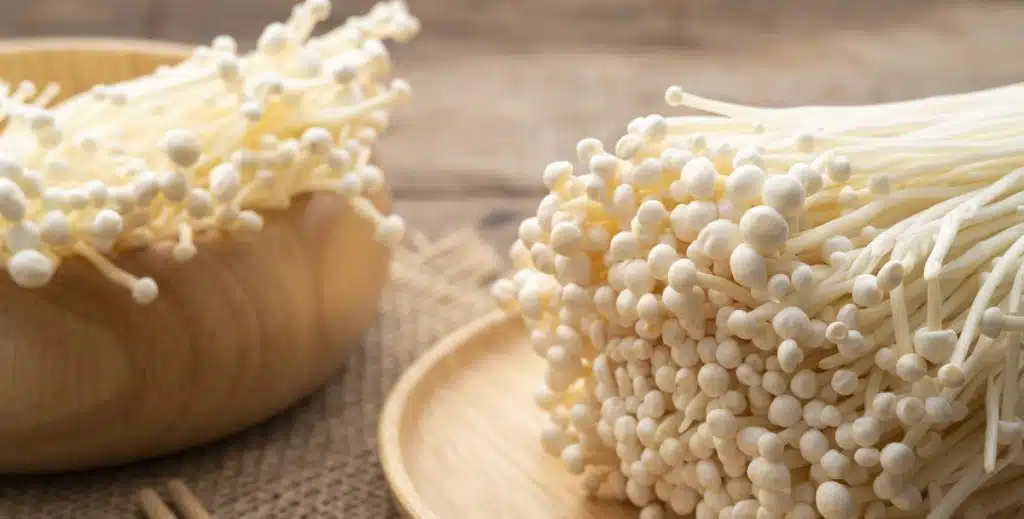Gourmet mushrooms are becoming more and more popular, and because of this, many grocery stores and farmer’s markets now have a wide range to choose from.
Cultivated enoki mushrooms are one of the more unique species you’ll come across, as they’re specially grown to have long, thin stems and tiny caps.
These delightful mushrooms are not only delicious and nutritious, but also provide several health benefits, and you can even grow them at home.
Read on to learn what enoki mushrooms are, what they look and taste like, how to cook them and how to grow them at home.
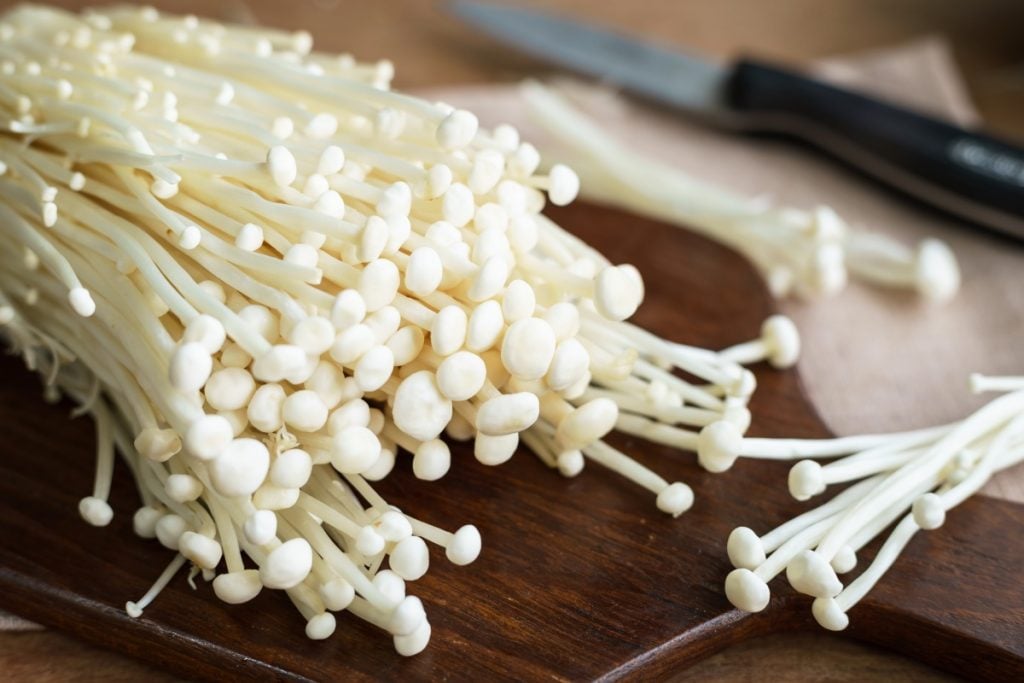
What Are Enoki Mushrooms?
Enokis (Flammulina filiformis) are popular gourmet mushrooms, typically white with long, thin stems and small caps.
They’re native to East Asia but now cultivated worldwide. Cultivated enoki looks very different from wild enoki, and growers use special conditions to give them their distinct appearance.
Although wild and cultivated enoki are both delicious edible mushrooms, people most often eat cultivated enokis as wild enokis have a toxic look-alike that makes foraging dangerous.
Enoki mushrooms have several other names, including golden needle mushrooms, velvet foot or velvet shank mushrooms, lily mushrooms and winter or snow puff mushrooms.
In Japan, they’re called enokitake. The Chinese call them jingu. In Korea, they’re known as paengi beoseot, and in Vietnam, nim kim châm or tram vang.
Where Do Wild Enoki Mushrooms Grow?
Wild enoki are common cold-weather mushrooms that grow throughout North America, Asia and Europe.
You’ll usually find them in late autumn or early spring, but in moderate climates, they’ll fruit throughout winter and sometimes even when there’s still snow on the ground.
Enokis are saprotrophs that grow on dead and dying hardwood trees, and you’ll usually find them growing in dense clusters on elms and willows.
But they also grow on aspen, poplar, birch, persimmon, ash, mulberry and maple trees, and in Asia prefer Chinese hackberry or enoki trees, giving them the name enokitake.
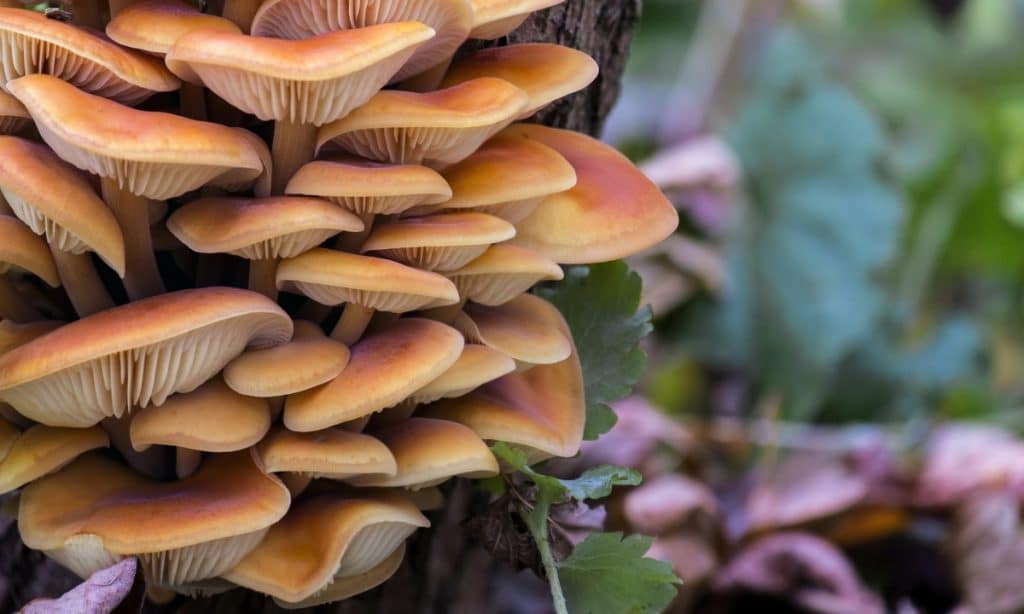
How to Identify Enoki Mushrooms?
Wild enokis and cultivated enoki are very different in appearance, so much so that they don’t even look like the same species.
The caps of cultivated enoki are typically white, while wild enokis have glossy, moist-looking brown caps that are darkest at the center, fading to yellow or tan at the edges. On the underside of their caps, they have closely spaced white to pale yellow gills.
The base of enoki stems are fuzzy. In wild species, the fuzzy coating is usually darker than the stem and looks like brown or black velvet, giving them the name velvet foot or velvet shank mushrooms.
Enoki grows in dense clusters on logs and stumps, and the stems of the individual mushrooms join at the base, forming an interconnected mass.
The reason wild and cultivated enoki look so different is their growing conditions. Wild enokis grow in sunny spots with lots of fresh air, giving them shorter stems and colored caps.
Mushroom farmers grow enoki in bottles in controlled conditions and use low light to keep them white and a high CO2 environment to promote long, thin stems and smaller caps.
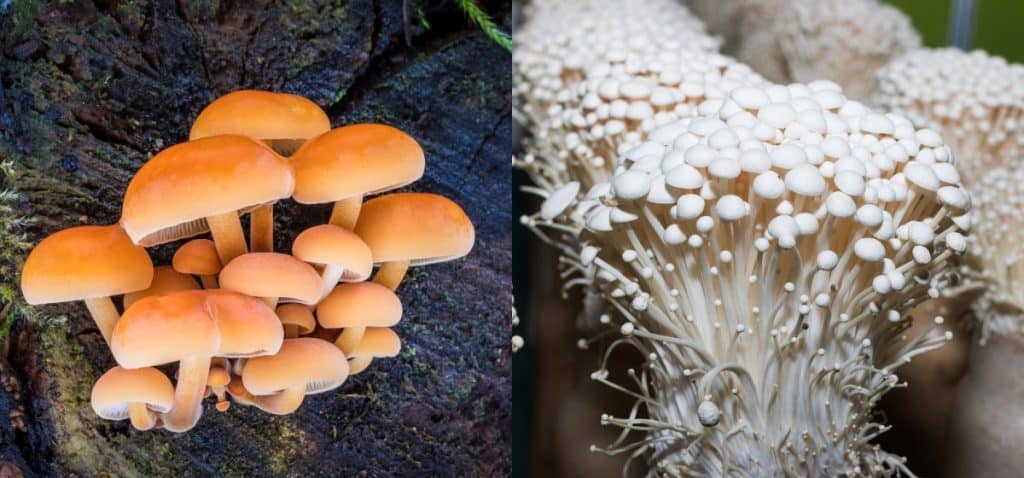
Enoki Mushroom Look-Alikes
Although wild enokis are relatively common and just as delicious as cultivated enoki, they are very similar to many other small brown mushrooms, including one that’s very dangerous.
Wild enoki often grows side-by-side with the deadly funeral bell mushroom (Galerina marginata), a toxic look-alike.
And although there are a few differences between the two species, the only way to be 100% certain which mushroom you have is to make a spore print and check the color of their spores.
Enokis have a white spore print, while the spores of the funeral bell are rusty brown.
Foraging for enokis is not recommended for beginners, and even experienced foragers suggest doing a spore print of every mushroom before eating them just to be 100% sure.
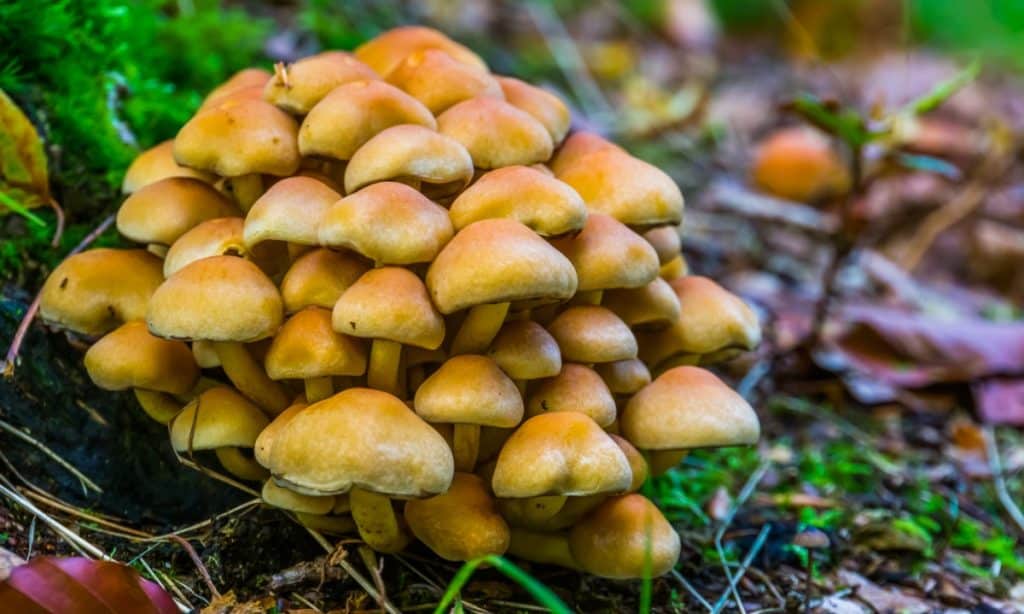
Can you Grow Enoki Mushrooms at Home?
Enoki mushrooms feed on dead and dying organic matter, and this means you can grow them at home.
They aren’t especially difficult to grow, but they enjoy cooler temperatures, and if you want them to grow long, thin stems, you’ll need to create a high CO2 environment.
Because of this, some grow kit suppliers suggest trying easy-to-grow species like oyster mushrooms first and only moving on to enoki mushrooms once you have some mushroom-growing experience.
Enoki mushrooms prefer hardwood substrates, and you’ll get the highest yields from supplemented sawdust or master’s mix. But like oyster mushrooms, they’ll grow on various organic substrates, including cardboard, straw and coffee grounds.
What Conditions Do Enoki Mushrooms Like?
Enokis prefer a warm, humid environment with substrate temperatures of 64 to 77°F (18 and 25°C) during incubation, but need much cooler temperatures for fruiting.
Temperatures of 45 to 50°F (7 to 10°C) will initiate pinning, and their ideal fruiting temperatures are 50 to 61°F (10 to 16°C).
Like most other mushrooms, they also need high relative humidity levels of 95 – 100% during pinning and 85 – 95% for fruiting.
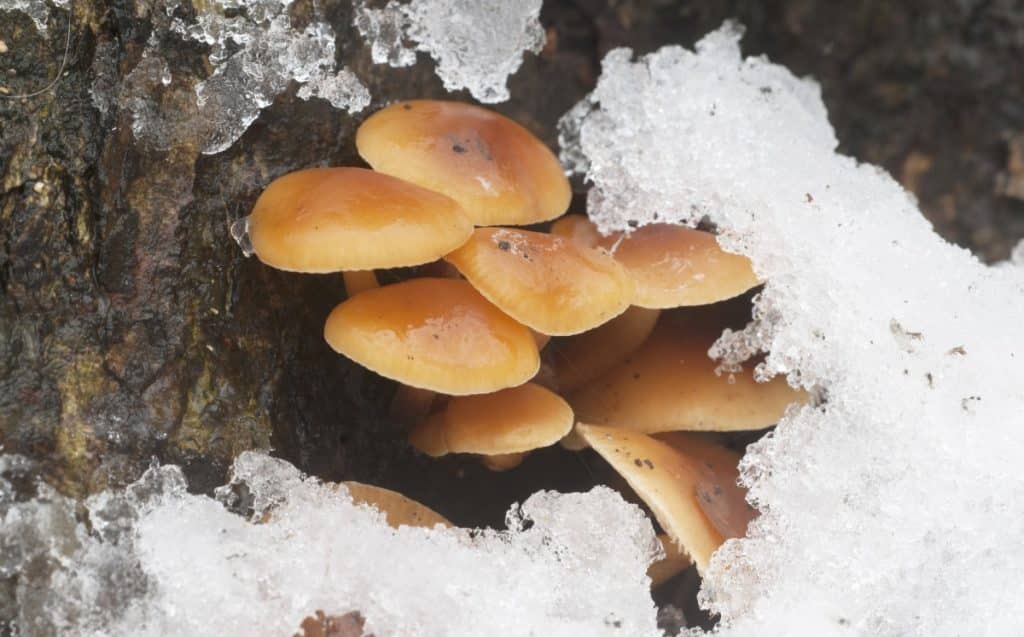
How Long Do Enoki Mushrooms Take to Grow?
How long it takes to grow enoki mushrooms varies depending on the growing conditions and the type of substrate you’re using.
If you buy a ready-to-fruit enoki mushroom grow kit, you could harvest your first mushrooms in under two weeks.
From the time you open your grow kit and expose the enoki mycelium to fruiting conditions, it usually takes 3 to 5 days for baby mushrooms called pins to form and then another 5 to 8 days for the mushrooms to grow.
If you start with spawn and inoculate a substrate, it can take 2 to 4 weeks for the mushroom mycelium to colonize the substrate.
And you can only place your bag or bottle in fruiting conditions once the enoki mycelium has fully colonized the substrate, meaning the entire process could take 4 to 6 weeks.
Can You Regrow Enoki Mushrooms?
Yes, you can regrow your enoki mushroom. After harvesting your enokis and cutting off the base of the stems, you can use the stem offcuts to grow more enoki mushrooms.
The process involves placing pieces of mushroom tissue or stem butts into a sterile, nutritious growing medium and leaving the mycelium to grow.
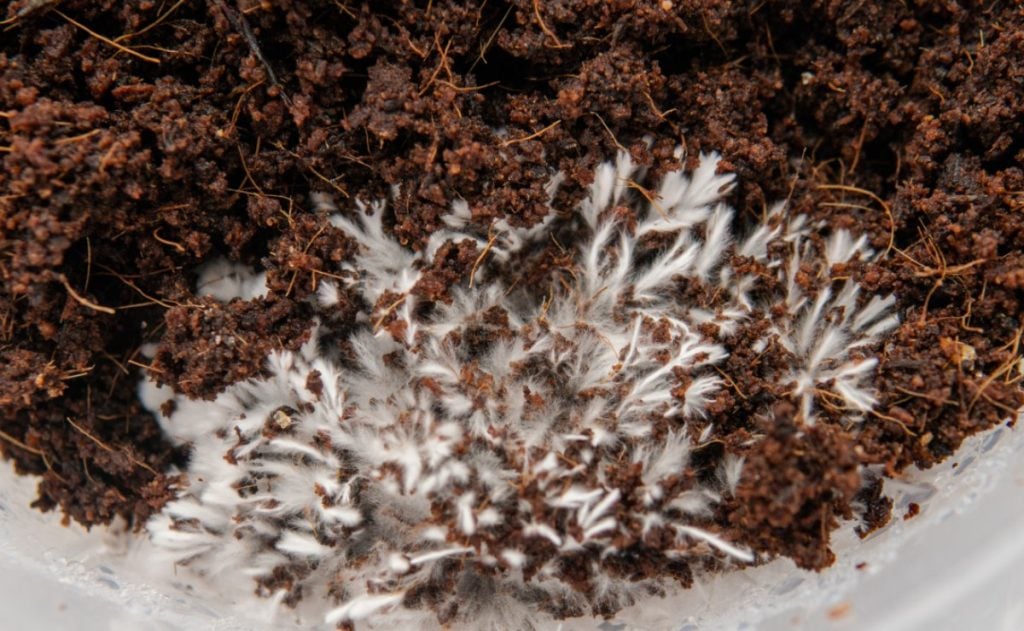
How to Grow Enoki Mushrooms Indoors
The easiest way for beginners to grow enoki mushrooms indoors is with a ready-to-fruit enoki mushroom grow kit.
But, once you have some experience, you may want to try more of the mushroom-growing process. The next step would be to make your own enoki mushroom fruiting block.
This process involves sourcing enoki mushroom spawn, preparing a substrate, and then inoculating and incubating the substrate.
How to Grow Enoki Mushrooms With a Grow Kit
Most enoki mushroom grow kits come as a bag of fully colonized substrate ready to place in fruiting conditions.
Growers have already done most of the work for you, and you can focus on the fun part, initiating pinning and watching your enoki grow.
Enokis need cold temperatures to start pinning, so suppliers recommend putting your kit into the fridge overnight before cutting the bag open.
Then place the open bag in a spot with temperatures between 50 to 61°F (10 to 16°C) and enough indirect light to read.
Mist the exposed mycelium with water regularly to maintain the humidity levels your enoki mushrooms need to grow.
It could take anywhere from 1 to 2 weeks for small mushroom pins to form and a week or more for the mushrooms to grow and be ready for harvest.
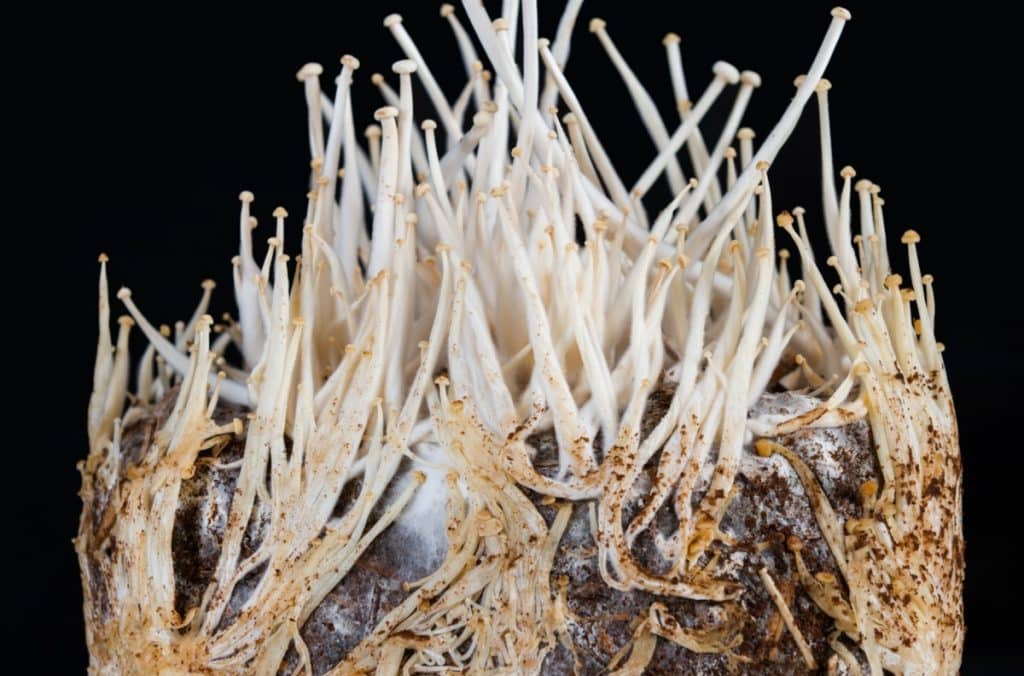
How to Grow Enoki Mushrooms Using Grain Spawn
Before you begin, you’ll need to decide which substrate to use.
If you choose a less nutritious substrate like straw or cardboard, you can get away with pasteurizing it to reduce the number of competing organisms.
But if you plan on growing your enoki on more nutritious substrates or adding supplements to provide additional nutrients, you’ll need to sterilize the substrate.
Follow the steps below to grow enoki mushrooms at home:
Step 1: Gather Supplies
First, you’ll need to order enoki mushroom spawn from a reputable supplier, preferably in your area, to reduce the time it takes for the grain spawn to get to you.
Then source your substrate material and any supplements you plan on using. We recommend using hardwood pellets or organic material readily available in your area.
Another decision is what container to use to grow your enoki mushrooms.
Commercial farmers usually grow enoki mushrooms in bottles, but you can use jars, bags or other suitable containers.
If you’re using a substrate that needs sterilization, you’ll need to use containers that can fit in a pressure cooker and withstand the temperatures required for sterilization.
Mushroom grow bags, glass jars, and plastic mushroom grow bottles all work well.
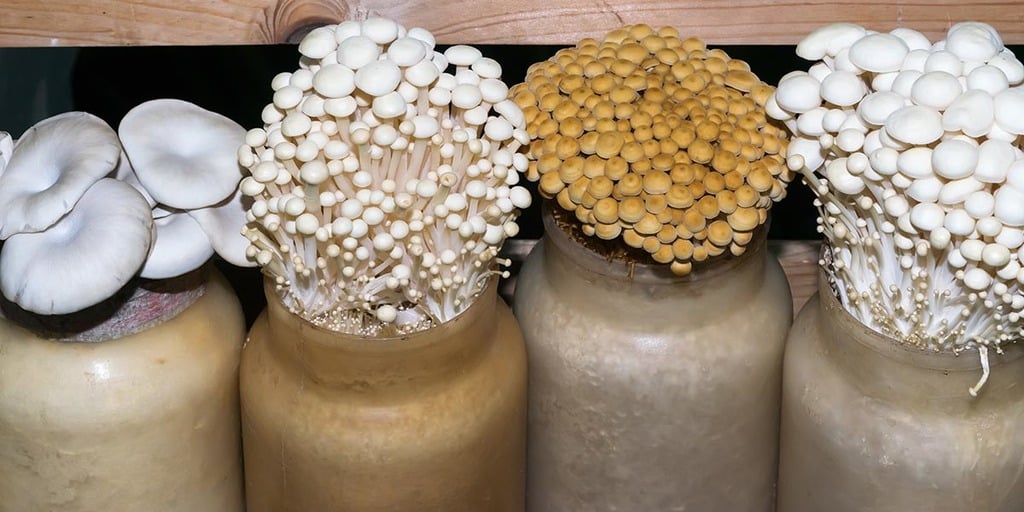
Step 2: Prepare the Substrate
Once you have all your supplies, the next step is to hydrate the substrate. You’ll also need to pasteurize or sterilize the substrate to remove competing organisms and give your mushroom mycelium a head start.
There are several ways to pasteurize a substrate using either hot or cold techniques. Our article on pasteurization has more information for you and details on the five easiest pasteurization methods.
Once you’ve pasteurized the substrate, you can put it into your containers, ready for inoculation.
Sterilization is a little different. The substrate is first hydrated, then put into the container and sterilized in the container.
To sterilize a substrate, you need temperatures higher than 250°F (121°C) for at least 2 hours. You can usually reach these temperatures in a pressure cooker with a pressure of 15 PSI.
Our article on sterilizing mushroom substrates has more information and a step-by-step guide.
Step 3: Inoculate the Substrate
Inoculation is the name given to the process of adding mushroom grain spawn to a nutritious growing medium.
Before you add enoki grain spawn to your substrate, ensure it has the correct moisture content and has cooled to room temperature. A substrate that is still too hot may kill the enoki mycelium.
When inoculating a substrate, growers usually add enoki spawn at a rate of 5 to 10% enoki grain spawn to the wet substrate.
When using bottles or jars, growers pour the spawn into a hole in the center of the substrate, but if you’re using bags to grow enokis, you have two options.
You can mix the enoki grain spawn throughout the substrate or add a layer of spawn on top of the substrate.
In our experience, mixing the spawn throughout the substrate reduces the time it takes for the mycelium to colonize the substrate.
Our article on inoculation has more information on the different distribution methods used to mix the grain spawn into the substrate.

Step 4: Incubation
Place your containers of inoculated substrate in a dark spot with temperatures of 64 to 77°F (18 and 25°C).
During incubation, the enoki mycelium grows off the grain spawn and spreads throughout the substrate, consuming the nutrients it provides.
It can take anywhere from 2 to 4 weeks for the enoki mycelium to fully colonize the substrate.
You’ll know it’s ready when white mycelium has covered the surface of the substrate and starts bunching together, forming knots or bumps.
Step 5: Fruiting
When colonization is complete, it’s time to shock the fruiting block to initiate pinning and place it in fruiting conditions. From this point, the process is the same as for fruiting a grow kit.
To make it easier to maintain the correct temperatures and humidity levels during fruiting, growers use fruiting chambers.
These come in all shapes and sizes, from small shotgun fruiting chambers made from totes to large walk-in grow tents.
If you want your enoki mushrooms to have long stems, place a sleeve around the mouth of your jar or bottle after pinning.
The sleeve will reduce airflow, creating higher CO2 levels that cause the enokis to grow tall, skinny stems in search of fresh air.

How to Grow Enoki Mushrooms Outdoors
If you live in an area with a cooler climate, you can also grow enoki mushrooms outdoors on hardwood logs.
When growing enoki this way, you won’t get the long stems and small caps sought after by chefs. Instead, you’ll get mushrooms that look like the ones you find in the wild.
And even though the taste is very similar, growing enoki outdoors is not as popular as indoor cultivation.
Our ultimate guide to growing mushrooms on logs has more information for you if this is the method you would like to use.
What Do Enoki Mushrooms Taste Like?
People describe the flavor of enoki mushrooms as mild, earthy and slightly sweet. They’re high in amino acids like guanylate, which gives them an intense umami taste.
Enokis add delicate flavors and a crunchy, slightly chewy texture to dishes, and their umami taste also enhances the flavors of other ingredients.
Wild enoki mushrooms don’t only look very different from the cultivated versions but also have deeper, earthier flavors.
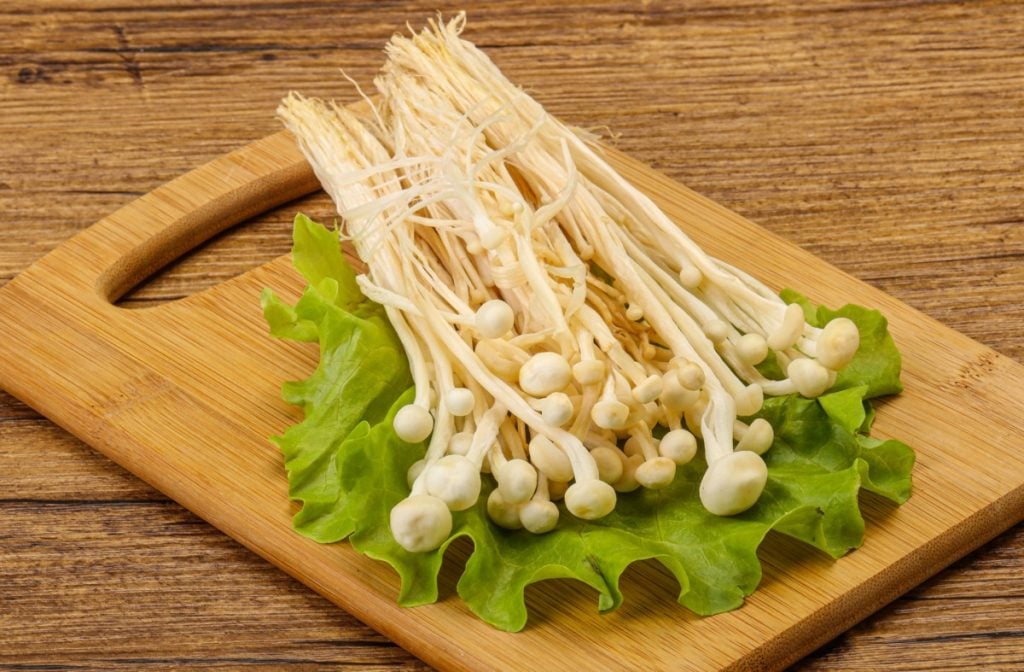
How Do You Eat Enoki Mushrooms?
Enokis are popular culinary mushrooms because of their unique appearance, flavor and texture. They’re very versatile, and their stems add a lovely crispy texture to salads, soups, hot pots, stews and stir-fries.
Don’t be afraid to experiment with enokis. Their mild, slightly sweet flavor and rich umami taste pairs well with most ingredients.
In Japan, China and Korea, they’re a staple ingredient in many dishes. People often use them to make nametake, a salty umami-packed condiment consisting of cooked enokis in a flavored soy sauce.
No other cultivated gourmet mushrooms look like enokis, and chefs enjoy using their long stems and small caps to add visual appeal to dishes.
Are Enoki Mushrooms Safe to Eat Raw?
Yes, you can eat enoki mushrooms raw, and people like to use them raw to give an extra crunch to salads, but generally, it is best to cook mushrooms before eating them.
Cooking enhances the enoki mushrooms’ flavor and rich umami taste. It also breaks down some of the beneficial compounds in enokis, making them easier to digest.

How to Store Enoki Mushrooms
Often, when you buy enoki mushrooms, they’ll come in a plastic-covered container. If the plastic is perforated and breathable, you can store them in their original packaging.
If not, it’s best to remove them from the plastic and store them in a paper bag on a shelf in your refrigerator to allow them to breathe. The crisper drawer is not the best place for them as it has limited airflow.
When stored correctly, enoki mushrooms will last for up to a week in the fridge, but it’s best to use them as soon as possible to prevent them from going bad.
Like many other mushrooms, raw enokis don’t freeze well, and they’ll lose their texture and become mushy when defrosted. One way that the Japanese get around this is to make enoki ice that lasts in the freezer for a couple of months.
To make enoki ice, blend fresh enoki mushrooms with water in a food processor and then simmer the mixture on the stove for 30 minutes to an hour until it reduces and thickens.
Allow the mixture to cool, place it in ice cube trays and freeze it. You can use the resulting enoki ice cubes to make stock and add flavor to rice dishes, stews and soups.
How to Clean Enoki Mushrooms
When cleaning enoki mushrooms, the first step is to trim off the mass at the base where the stems join and separate the mushrooms into smaller clumps or individual stems.
Next, remove any slimy, discolored or bruised mushrooms and dunk the rest in a bowl of cold water to remove any dust or debris.
Drain them in a colander and then pat them dry with a paper towel or lay them out to dry on a kitchen towel.
Our article on cleaning mushrooms has more information and tips and tricks for cleaning different types of mushrooms.
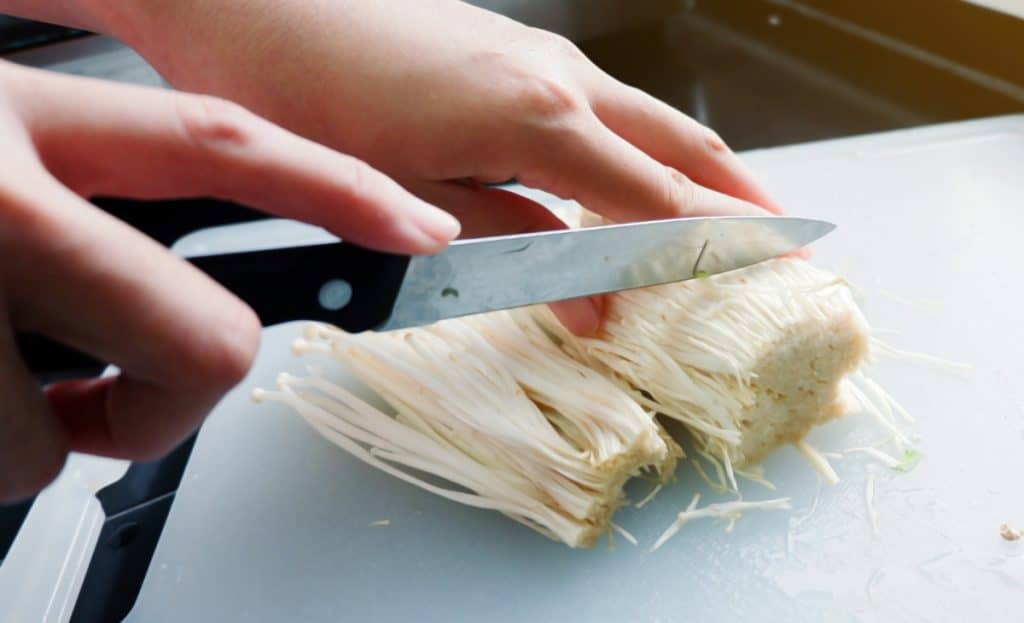
How to Cook Enoki Mushrooms
Enokis thin stems and fragile caps cook extremely fast, so be careful not to overcook them.
Sauteing is our favorite way to cook mushrooms, and it only takes 2 to 3 minutes to make delicious crispy sauteed enokis. Be aware that the longer you cook them, the chewier they become.
The same applies when stir-frying enokis on high heat, except they cook even faster. Your stir-fried enokis could be crispy and ready to eat in under 2 minutes.
One of the healthiest ways to cook enokis is to steam them or add them directly to soups and stews.
Sauteed Enoki Mushroom Recipe
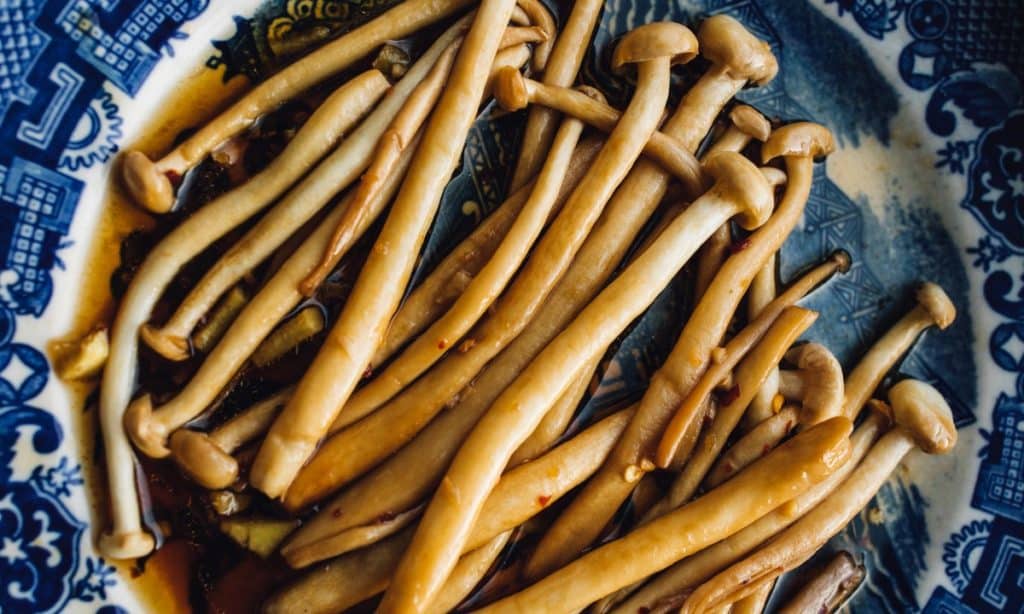
This quick and easy enoki mushroom recipe adapted from A Couple Cooks gives you irresistible, crispy, umami-packed enokis in less than 5 minutes.
Ingredients
- 8 ounces (226 grams) of enoki mushrooms, around 2 clusters
- 2 tablespoons sesame oil (standard, not toasted)
- 2 medium garlic cloves minced
- 1 tablespoon tamari or soy sauce
- Thinly sliced chives or green onions to garnish
Instructions
- Cut off the base of the enoki cluster and separate the mushrooms into smaller clumps or individual stems. Then wash the enokis and pat them dry.
- Heat the sesame oil over medium-high heat. Add the enoki mushrooms and saute them for 1 minute.
- Add the garlic and cook until softened and fragrant, about 30 seconds, then stir in the soy sauce and remove from the heat.
- Serve immediately, garnished with sliced chives or green onion tops.
Health Benefits of Enoki Mushrooms
Like other mushrooms, enokis are very nutritious and contain several biologically active compounds that provide a range of health benefits.
A 100g serving of enoki mushrooms contains:
- 0.3g Fat
- 2.7g Protein
- 7.8g Carbohydrate
- 0.2g Sugars
- 2.7g Fiber
They’re also high in copper, niacin (Vitamin B3), antioxidants and essential amino acids.
The dietary fiber, polysaccharides, and mycosterol they contain help to control blood sugar and reduce blood pressure and cholesterol.
Enokis also contain bioactive polysaccharides that have cancer-fighting properties, help boost the immune system and may help with brain function and memory.

Final Thoughts
Enokis are versatile gourmet mushrooms with a unique appearance, flavor and texture.
Wild enoki mushrooms look very different from cultivated enokis that farmers grow in dark CO2-rich environments to give them their white color and long stems.
You’ll often find enokis in grocery or specialty stores, but if that’s not the case in your area, you can grow enokis at home.
To learn more about growing mushrooms the low-tech way, visit our Mushroom Growing Hub.
